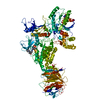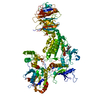+Search query
-Structure paper
| Title | Pharmacology of LRRK2 with type I and II kinase inhibitors revealed by cryo-EM. |
|---|---|
| Journal, issue, pages | Cell Discov, Vol. 10, Issue 1, Page 10, Year 2024 |
| Publish date | Jan 23, 2024 |
 Authors Authors | Hanwen Zhu / Patricia Hixson / Wen Ma / Ji Sun /  |
| PubMed Abstract | LRRK2 is one of the most promising drug targets for Parkinson's disease. Though type I kinase inhibitors of LRRK2 are under clinical trials, alternative strategies like type II inhibitors are being ...LRRK2 is one of the most promising drug targets for Parkinson's disease. Though type I kinase inhibitors of LRRK2 are under clinical trials, alternative strategies like type II inhibitors are being actively pursued due to the potential undesired effects of type I inhibitors. Currently, a robust method for LRRK2-inhibitor structure determination to guide structure-based drug discovery is lacking, and inhibition mechanisms of available compounds are also unclear. Here we present near-atomic-resolution structures of LRRK2 with type I (LRRK2-IN-1 and GNE-7915) and type II (rebastinib, ponatinib, and GZD-824) inhibitors, uncovering the structural basis of LRRK2 inhibition and conformational plasticity of the kinase domain with molecular dynamics (MD) simulations. Type I and II inhibitors bind to LRRK2 in active-like and inactive conformations, so LRRK2-inhibitor complexes further reveal general structural features associated with LRRK2 activation. Our study provides atomic details of LRRK2-inhibitor interactions and a framework for understanding LRRK2 activation and for rational drug design. |
 External links External links |  Cell Discov / Cell Discov /  PubMed:38263358 / PubMed:38263358 /  PubMed Central PubMed Central |
| Methods | EM (single particle) |
| Resolution | 3.4 - 3.8 Å |
| Structure data | EMDB-29340, PDB-8fo7: EMDB-41982, PDB-8u7h: EMDB-41985, PDB-8u7l: EMDB-42019, PDB-8u8a: EMDB-42020, PDB-8u8b: |
| Chemicals |  ChemComp-GDP: 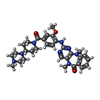 ChemComp-4K4: 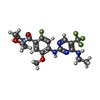 ChemComp-A0T:  ChemComp-T3X: 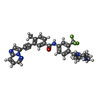 ChemComp-0LI:  ChemComp-919: |
| Source |
|
 Keywords Keywords | HYDROLASE/HYDROLASE INHIBITOR /  Cryo-EM / Cryo-EM /  Parkinson's disease / Parkinson's disease /  Kinase / Kinase /  LRRK2 / type I inhibitor / LRRK2-IN-1 / HYDROLASE-HYDROLASE INHIBITOR complex / LRRK2 / type I inhibitor / LRRK2-IN-1 / HYDROLASE-HYDROLASE INHIBITOR complex /  HYDROLASE / type II inhibitor HYDROLASE / type II inhibitor |
 Movie
Movie Controller
Controller Structure viewers
Structure viewers About Yorodumi Papers
About Yorodumi Papers




